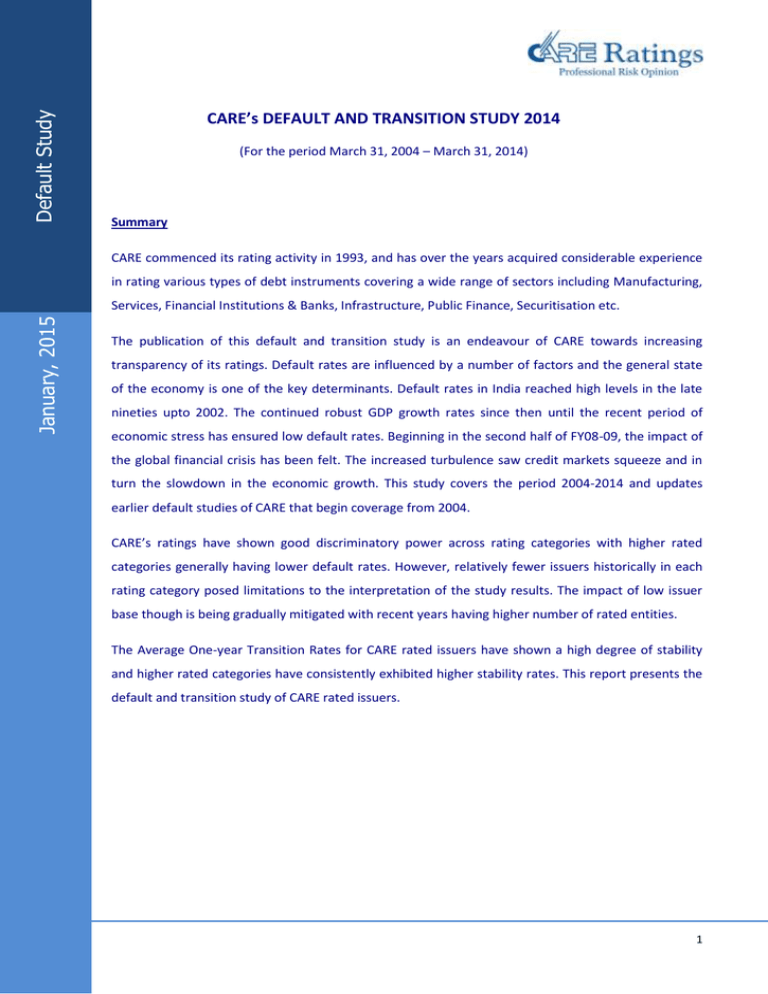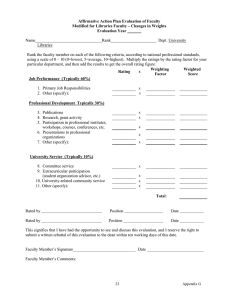udy lt St au
advertisement

Default Study CARE’s DEFAULT AND TRANSITION STUDY 2014 (For the period March 31, 2004 – March 31, 2014) Summary CARE commenced its rating activity in 1993, and has over the years acquired considerable experience in rating various types of debt instruments covering a wide range of sectors including Manufacturing, January, 2015 Services, Financial Institutions & Banks, Infrastructure, Public Finance, Securitisation etc. The publication of this default and transition study is an endeavour of CARE towards increasing transparency of its ratings. Default rates are influenced by a number of factors and the general state of the economy is one of the key determinants. Default rates in India reached high levels in the late nineties upto 2002. The continued robust GDP growth rates since then until the recent period of economic stress has ensured low default rates. Beginning in the second half of FY08-09, the impact of the global financial crisis has been felt. The increased turbulence saw credit markets squeeze and in turn the slowdown in the economic growth. This study covers the period 2004-2014 and updates earlier default studies of CARE that begin coverage from 2004. CARE’s ratings have shown good discriminatory power across rating categories with higher rated categories generally having lower default rates. However, relatively fewer issuers historically in each rating category posed limitations to the interpretation of the study results. The impact of low issuer base though is being gradually mitigated with recent years having higher number of rated entities. The Average One-year Transition Rates for CARE rated issuers have shown a high degree of stability and higher rated categories have consistently exhibited higher stability rates. This report presents the default and transition study of CARE rated issuers. 1 Default Study CARE’s Default Study This section examines default experience of CARE’s long-term and medium-term ratings from March 31, 2004 to March 31, 2014. CARE has used Cohorts method to calculate the performance of CARE rated entities across various rating categories. Category-wise Cumulative Default Rate (CDR) is calculated for each cohort within the period of study. The CDR is calculated over one, two and three year time horizons to evaluate the performance of ratings over varying periods. Then the issuer weighted average for one-year, two-year and three-year CDR is computed to arrive at the long term CDR for each category. As ratings are a measure of Probability of Default, a higher rating given to an entity implies lower credit risk and should therefore have lower CDR and CARE’s CDR numbers generally display this property. CARE’s definition of default for this CDR study and detailed methodology for computing CDR is presented in Annexure. The CDR study includes ratings of issuers across all sectors – banks, financial institutions and corporates. Ratings of Structured Obligations (SO) are not a part of this study which would comprise securitisation transactions, ratings backed by third-party guarantees or instruments with a structured payment mechanism. Static Pool / Cohort The study tracks the long/medium-term ratings assigned and accepted by the issuer and is based on issuer-specific data and not instrument-specific data (thus counting an issuer only once). The rating of senior-most long-term debt of an issuer is considered as the rating of that issuer. If CARE has not rated the long-term instrument of that issuer, then the medium-term rating is considered as the issuer’s rating. Static pools / Cohorts for the study are the number of issuers outstanding in each rating category as on the beginning of each cohort falling within the study period. Default experience of each rating category for each cohort is examined over one, two and three-year periods. 2 Default Study Rating category-wise number of issuers is presented below in Table 1: Table 1: Issuers Outstanding at the beginning of each Cohort period Number of Issuers at the beginning of the cohort period as on 31st Rating Category Mar-04 Mar-05 Mar-06 Mar-07 Mar-08 AAA 15 15 21 23 31 44 49 53 59 57 AA 31 39 48 48 63 93 116 147 162 167 A 19 16 24 30 64 167 220 289 345 303 BBB 12 13 15 11 33 272 561 866 1064 1139 BB 2 3 2 2 1 60 183 375 806 1262 B 1 0 2 0 0 8 24 41 264 589 C 1 1 0 0 0 1 3 10 31 59 Total 81 87 112 114 192 645 1156 1781 2731 3576 Median Rating AA AA AA AA A BBB BBB BBB BBB BB Mar-09 Mar-10 Mar-11 Mar-12 Mar-13 Key Observations The period beginning from March 2008 witnessed a structural shift in the rating universe as the Basel II standardized approach for credit risk was implemented for banks by RBI. Two key changes that can be observed are the multiple times increase in the overall number of issuers and the increase in issuer rated below AA category between March 2008 and March 2009. In India, the banking sector is still the primary source of debt funding and prior to Basel II implementation, bank borrowings of companies were unrated. Post Basel II implementation, many of the corporates with bank borrowings are getting rated leading to the manifold increase in number of issuers, especially in the lower grades. The corporate bond market in India is skewed towards higher rated entities. Therefore, the rating universe primarily comprised of higher rated borrowers before Basel II implementation. The median rating based on the above rating universe progressively moved down from AA during March 2004-2007 period to BBB for 2009-2012 and was BB for issuers at the beginning of March 31, 2013. 3 Default Study CARE’s Cumulative Default Rate CARE’s one-year, two-year and three-year cumulative issuer weighted average default rates consistently follow the principle of ordinality and are lower in the higher rating categories and increase as we move down the rating categories (presented in Table 2 below) Table 2: CARE’s Issuer Weighted Cumulative Default Rates for the period March 2004 - March 2014 One year Two Year Three Year Rating Category Avg. No. of Issuers CDR (%) Avg. No. of Issuers CDR (%) Avg. No. of Issuers CDR (%) AAA 36.7 0.00 34.4 0.00 31.4 0.00 AA 91.4 0.00 83.0 0.40 73.1 0.85 A 147.7 0.47 130.4 1.79 103.6 2.53 BBB 398.6 1.63 316.3 3.65 222.9 5.27 BB 269.6 4.82 159.3 9.48 78.5 11.46 B 92.9 9.15 37.8 15.00 9.5 14.47 C 10.6 26.42 5.2 40.43 2.0 18.75 Total 1047.5 3.01 766.6 4.84 521.0 4.94 The categories of AA, A, BBB, BB, B and C include ratings with the suffix ‘+’ or ‘–‘ within the respective categories. Thus, for instance, the AA category includes three ratings: AA+, AA and AA-. Key Observations There were no instances of default (in any Cohort) in AAA rating category during the period of this study. Small sample size limitations have gradually reduced with average sample size of three year CDR computation being above 50 for all investment grade categories (except AAA). However, with the exception of BBB and A category, the sample size for all categories is less than 100. For the one-year and the two-year CDRs sample size has improved due to inclusion of recent cohorts. As the sample size continues to increase more meaningful conclusions can be reached. It can be observed that CARE’s CDRs display good discriminatory power with higher rating categories having lower CDRs. 4 Default Study CARE’s structured obligation ratings include Asset Backed Securitization (ABS), Mortgage Backed Securitization (MBS), Obligations of state level entity backed by state/central government guarantee and instruments backed by credit enhancing guarantees / letter of comfort etc. While structured obligation ratings are not part of this study, the ABS and MBS ratings which form majority of CARE’s structured obligation ratings have not witnessed any default or downgrade. Transition Study Rating transition study looks at how ratings have changed over a period of time, an important aspect analyzed by CARE to evaluate the stability/migration of its ratings. Methodology for transition rates Methodology used by CARE for studying rating transition is discussed below: The static pools, also known as cohorts, are created by grouping issuer ratings according to the year in which the ratings are active and outstanding at the beginning of the year. The study tracks the long/medium-term ratings assigned and accepted by the issuer on a year-to-year basis. The study is based on issuer-specific data and is not instrument-specific. Thus, it counts an issuer only once and avoids distortion. The transition study includes ratings of issuers across all sectors – banks, financial institutions and corporates. Structured Obligations (SO) are not a part of this study. Individual cohorts have been formed for each year under study; in all 9 cohorts have been prepared for the period of study. Each individual cohort for a given financial year consists of the ratings outstanding in various rating categories at the beginning of the financial year and tracks the changes in rating, if any, during the one-year period therefrom. For example, the 2004 cohort represents the ratings outstanding as on March 31, 2004 and their transitions or changes (upgrades, downgrades and re-affirmation) in the subsequent year till March 31, 2005. Data from all individual cohorts have been pooled together to obtain the weighted average transition matrix. Since the rating of an issuer both at the beginning and the end of a study period is required for the computation of transition rate, any issuer whose rating has been withdrawn / suspended has been removed from the relevant opening cohort. 5 Default Study The table shows issuer weighted average transition rates on the CARE rating scale over the period 2004-2014. Table 3: Average 1-year Rating Transition Rates for the period Mar 2004- Mar 2014 (%) IssuerYears AAA AA A BBB BB B C D AAA 361 98.61 1.39 0.00 0.00 0.00 0.00 0.00 0.00 AA 891 0.90 94.57 3.96 0.23 0.23 0.12 0.00 0.00 A 1422 0.00 2.61 85.84 9.44 1.30 0.23 0.07 0.51 BBB 3690 0.00 0.09 2.88 87.22 7.41 0.55 0.03 1.82 BB 2241 0.00 0.00 0.00 6.05 81.12 5.41 0.64 6.77 B 738 0.00 0.00 0.00 0.54 11.66 72.99 1.21 13.60 C 84 0.00 0.00 0.00 1.19 13.26 23.28 27.87 34.40 Below Investment Grade refers to ratings below BBB- (i.e. BB+ till D) The categories of AA, A, BBB, BB, B and C include ratings with the suffix ‘+’ or ‘–‘ within the respective categories. Thus, for instance, the AA category includes three ratings: AA+, AA and AA-. The diagonals of the above table represent the stability of a particular rating category in one year for the period Mar 2004 – Mar 2014. Based on CARE’s average one-year transition matrix, it can be inferred that out of all the AA rated companies at the beginning of the year, 94.59% have remained in the same category, 0.88% have been upgraded to AAA and 4.53% have been downgraded. Similar interpretation can be done for other rating categories as well. Stability of Ratings Stability rate for each rating category indicates percentage of ratings remaining in the same category at the end of one year. One-year average stability of CARE’s ratings during the period 2004-2014 is presented below: 6 Default Study It can be observed from the above chart that CARE’s higher rating categories AAA and AA exhibit high level of stability within one-year period. Stability rates of CARE’s higher rating categories have generally been higher than those for the lower rating categories. Disclaimer CARE has taken due care and caution in compilation of the data for this publication. Information has been taken by CARE from sources it considers accurate and reliable. CARE does not guarantee accuracy, adequacy or completeness of any information and is not responsible for any errors or omissions for the results from the use of such information. CARE especially states that it has no financial liability whatsoever to any use on account of the use of information provided in this publication. This material is not intended as an offer or solicitation for purchase or sale of any financial instruments. CARE’s ratings are opinions on credit quality and are not recommendations to buy, sell or hold any security. CARE has based its ratings on information obtained from sources believed by it to be accurate and reliable. CARE does not, however, guarantee the accuracy, adequacy or completeness of any information and is not responsible for any errors or omissions or for the results obtained from the use of such information. Most issuers of securities rated by CARE have paid a credit rating fee, based on the amount and type of securities issued. 7 Default Study Annexure Definition of Default for the Study For the purpose of this study, default has been defined as any missed payment on the rated instrument i.e. a single rupee delay even for a single day has been treated as default. A default recognition criterion for bank facilities is specifically detailed in our website (. Concept of Static Pool / Cohort Static Pool / Cohort for the study is the number of issuers outstanding in each rating category as on a given date. Default experience of each rating category is examined over the study period. New issuers during the study period are not considered and in that sense the data pool remains static. If the rating of the company included in the cohort gets withdrawn, it is treated as withdrawal for the rest of the period of the cohort. If the company whose rating is included in the cohort defaults, it is treated as default for the rest of the period of the cohort. However those entities, which are rated again after withdrawal or which recover from default (and are rated again), are taken as new entities for relevant subsequent cohorts. Structured obligation (SO) ratings are not part of this study. CARE’s structured obligation ratings include Asset Backed Securitization (ABS), Mortgage Backed Securitization (MBS), Obligations of state level entity backed by state/central government guarantee and instruments backed by credit enhancing guarantees / letter of comfort etc. 8 Default Study Cumulative Default Rate (CDR) Cumulative Default Rate (CDR) shows the number of defaults from a given static pool as a proportion of total issuers in that static pool and provides an estimate of default frequency. For a given static pool, three-year CDR is computed as follows: Three-Year CDR = No. of issuers which defaulted over the three-year period / No. of issuers outstanding at the beginning of the three-year period. A hypothetical example is presented here: Cohort 1 Cohort 2 Opening Issuers Defaults during next 3 years Opening Issuers Defaults during next 3 years (A) (B) = (B/A) (%) (A) (B) = (B/A) (%) AAA 50 0 0.00 60 0 0.00 AA 40 1 2.50 50 1 2.00 A 30 2 6.67 20 2 10.00 BBB 20 3 15.00 15 3 20.00 3 Yr CDR 3-Yr CDR Issuer weighted average three-year CDR is computed to arrive at the average CDR over a specified period of time. The above example is continued here to arrive at the average CDR: Cohort 1 Cohort 2 3 Yr CDR Opening Issuers 3 Yr CDR Opening Issuers (C1) (%) (W1) (C2) (%) (W2) AAA 0.00 50 0.00 60 0.00 AA 2.50 40 2.00 50 2.22 A 6.67 30 10.00 20 8.00 BBB 15.00 20 20.00 15 17.14 Weighted Average 3 Yr CDR =(C1*W1+C2*W2)/(W1+W2) (%) 9 Default Study Analyst Contact: T.N.Arun Kumar Chief General Manager 91-22-67543412 arun.kumar@careratings.com Vijay Agrawal Joint General Manager 91-22-67543416 vijay.agrawal@careratings.com 10





